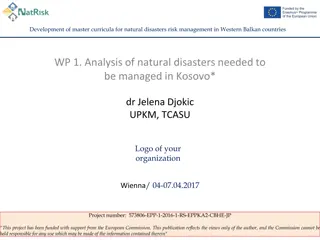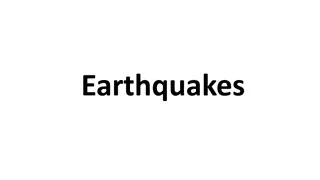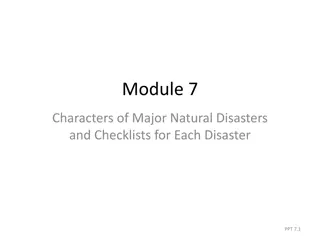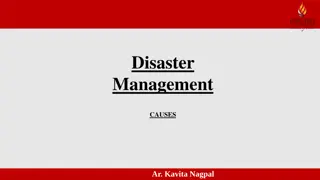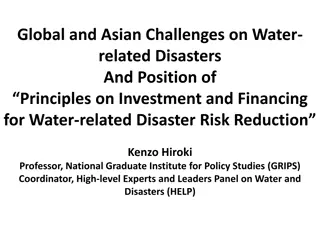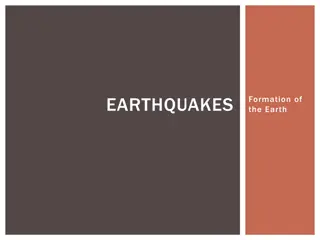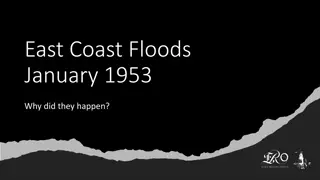Preparing for Natural Disasters: Earthquakes, Extreme Heat, and Floods
Natural disasters like earthquakes, extreme heat, and floods pose significant risks across the United States, impacting various states and territories. Understanding the characteristics and potential dangers of each disaster type is crucial for effective preparedness. This guide highlights essential tips and actions for staying safe during earthquakes, extreme heatwaves, and floods, emphasizing the importance of prevention, recognizing symptoms of heat-related illnesses, and taking necessary precautions to mitigate risks. Proper planning, awareness, and readiness can help individuals and families better cope with these unpredictable events.
Download Presentation

Please find below an Image/Link to download the presentation.
The content on the website is provided AS IS for your information and personal use only. It may not be sold, licensed, or shared on other websites without obtaining consent from the author. Download presentation by click this link. If you encounter any issues during the download, it is possible that the publisher has removed the file from their server.
E N D
Presentation Transcript
Get Ready for an Earthquake Earthquakes are the sudden, rapid shaking of the earth caused by the breaking and shifting of rock deep underground Including Illinois, Indiana, and Wisconsin, there are 45 states and territories in the US at moderate to high risk for earthquakes Most deaths and injuries occur by falling objects and debris or when buildings collapse An earthquake of similar or lesser intensity that follows the main earthquake. The break in the earth s crust which moves during an earthquake. The movement may range from less than an inch to more than 10 yards The place on the earth s surface where the earthquake rupture began. Vibrations that travel outward from the earthquake fault at speeds of several miles per second. The amount of energy released during an earthquake, which is computed from the amplitude of the seismic waves. Aftershock Fault Epicenter Seismic Waves Magnitude
Get Ready for an Earthquake Stay or go? The best action for you and your family will typically be to shelter in place. Remain calm, stop and take cover from falling debris. After the earthquake, remain aware of aftershocks and look for hazards like broken glass, fallen trees or downed power lines before you move from your location. Important Activities Properly insure your home and belongings. Properly secure breakable objects and hang picture frames or heavy items away from beds, couches, and anywhere people sit. Locate safe spots in each room and take cover under a sturdy table or against an inside wall. Hold earthquake drills with your family members so everyone knows what to do.
Get Ready for Extreme Heat Heat is the number one weather-related killer in the United States. Heat kills by pushing the human body beyond its limits and makes the body work extra hard to maintain a normal temperature. Your best defense against heat-related illnesses is prevention. Recognize the Symptoms of Heat-Related Illnesses Heat Exhaustion: Heavy sweating Fainting Dizziness Pale skin Headaches Muscle cramps Heat Stroke: High temperature of 103 F+ Hot, red, dry skin Rapid pulse, weak or strong No sweating Dizziness, nausea and confusion Possibly unconscious
Get Ready for Extreme Heat Ways to be prepared for extreme heat: Drink plenty of water. Install window air conditioners snugly and check air conditioning ducts for proper insulation. Install temporary window reflectors for use between windows and drapes to reflect heat back outside. Weather-strip doors and sills to keep cool air in. Cover windows that receive morning or afternoon sun. Keep storm windows up all year. Check on family, friends, and neighbors who are alone and do not have air conditioning, especially those 65 years of age or older. Is your family at higher risk? Conditions that can increase risk include old age, obesity, fever, dehydration, heart disease, poor circulation and sunburn. Heat-related illnesses can be induced by poor air quality and little to no air circulation.
Get Ready for a Flood Floods are one of the most common hazards in the U.S. Not all floods are the same. Flood Watch Flooding is possible Flash flooding is possible. Be prepared to move to higher ground Flooding is occurring or will occur soon; if advised to evacuate, do so immediately A flash flood is occurring; seek higher ground on foot immediately Flash Flood Watch Flood Warning Flash Flood Warning Stay or go? If you are not evacuating, plan for moving essential items to an upper floor and sticking to higher ground. If you are advised to evacuate, do so immediately. Evacuation is simple and safer before the flood waters rise. Have your evacuation plan, and follow recommended routes.
Get Ready for a Flood Helpful Equipment The following materials can help you construct barriers to stop floodwater from entering your home: Plastic sheeting Lumber Nails Hammer Saw Shovels Sandbags Important activities Find out if you live in a flood-prone area by visiting www.floodsmart.gov Know if your property is above or below the flood stage water level As your insurance agent about flood insurance. Raise items in basements and ground level to upper floors or higher off the ground to prevent damage from floodwaters
Get Ready for a Fire Fire Basics: Fires affect thousands of Americans and cause billions of dollars in damage every year. Fires can be particularly deadly because they spread so quickly Suffocation is the leading cause of fire-related deaths Make a Fire Escape Plan Make sure all family members know what to do in case of a fire. Practice feeling the door before opening it. If the door is hot, get out another way. Draw a floor plan with at least two escape routes from every room of your home. Select a location outside your home where everyone will meet after escaping. Practice your escape plan at least once a month.
Get Ready for a Fire To help keep your home safe: Install a smoke alarm inside each sleeping area and on each level of your home. Test each smoke alarm once a month and replace bad batteries immediately. Regularly replace batteries consider using daylight savings as a reminder to do so. Replace smoke alarms every 10 years. Sleep with the doors closed to slow the spread of the fire. Keep one or more working fire extinguishers in your home and know how to use them. Never leave something cooking on the stove unattended. Keep matches and lighters safely out of reach of children. Place heaters at least three feet away from flammable material. Do not overload outlets or extension cords. Make sure your home s address can be clearly seen from the street.
Get Ready for Foodborne Illness Food poisoning is any illness resulting from the consumption of contaminated food, pathogenic bacteria, viruses, or parasites that contaminate food. 48 million people (1 in 6 Americans) in the U.S. get sick from contaminated food annually. Common symptoms range from mild to serious and they include: Upset stomach Abdominal cramps Nausea and vomiting Diarrhea Fever Dehydration Some things that can contribute to foodborne illness are: Inadequate hand-washing Cross-contamination Storage and cooking temperatures Contamination of food by waste
Get Ready for Foodborne Illness Important activities to properly store and handle food Foods that can spoil should be refrigerated or frozen promptly. Cook meat to the proper temperature: 145 degrees for roasts, steaks, and chops of beef, veal, pork, and lamb 160 degrees for ground beef, veal, pork, and lamb 165 degrees for poultry Wash fruits and vegetables under running water. Keep raw meat, poultry, seafood, and their juices away from other foods. Wash your hands for at least 20 seconds with warm, soapy water before and after handling raw food.
Get Ready for Pandemic Influenza An influenza pandemic is a global outbreak of a new version of the flu virus that can spread easily from person to person. Take these steps to protect your health: Cover your nose and mouth with a tissue when you cough or sneeze. Wash your hands often with soap and water, especially after you cough or sneeze. Avoid touching your eyes, nose or mouth. Germs spread this way. Try to avoid close contact with sick people. If you get sick with influenza, stay home from work or school and limit contact with others Have extra supplies on hand Two week supply of water and food Continuous supply of your regular prescription drugs Non-prescription drugs and other health supplies (pain relievers, cough and cold medicines)
Get Ready for Pandemic Influenza An outbreak is likely to be widespread and may affect your everyday life. Changes may involve everyday supplies and services, overwhelmed doctors and hospitals, and restrictions on travel and public gatherings. An outbreak is likely to be widespread and may affect your everyday life. Changes may involve everyday supplies and services, overwhelmed doctors and hospitals, and restrictions on travel and public gatherings. Important activities Get a yearly flu vaccination, especially if you are at high risk for flu complications. Practice good hygiene and wash your hands frequently. Cover your nose and mouth when coughing or sneezing. Regularly clean surfaces that are touched by multiple people. Stay healthy by eating a balanced diet, getting regular exercise and getting enough rest.
Get Ready for a Thunderstorm Thunderstorms can bring high winds, heavy rains and dangerous lightning, one of the leading causes of weather-related deaths in the United States each year. In Illinois, Indiana, and Wisconsin, severe thunderstorms frequently occur in the late afternoon or evening. Wisconsin had 290 lighting strikes between 2000 and 2010, resulting in five deaths, 56 injuries, and about $47 million in property damage. If you can see lightning, go indoors and wait 30 minutes after you hear the last clap of thunder to go outside.
Get Ready for a Thunderstorm Important activities Remove dead trees and rotten branches that could fall and cause injury or damage. Secure outdoor objects that could blow away or cause damage. Shutter windows and secure outside doors. Postpone outdoor activities if a thunderstorm is likely in your area. Avoid showering or bathing. Plumbing can conduct electricity. Use a corded telephone only for emergencies. Unplug appliances and other electrical items such as computers and turn off air conditioners. Power surges from lightning can cause serious damage. Listen for weather updates from local officials
Get Ready for a Tornado Tornadoes can appear suddenly and without warning. These violent storms can pack winds of up to 300 mph and leave damage trails up to 1 mile wide and 50 miles long. Illinois, Indiana, and Wisconsin average between 23 and 26 tornadoes a year. Know the signs that a tornado could be imminent: Dark, often greenish sky. A large, dark rotating cloud (funnel-shaped) Large hail, which is often produced by the same storms that produce tornadoes. Loud roar, similar to the sound of a freight train. Tornadoes may occur and be visible near the trailing edge of a thunderstorm. Tornadoes may also be embedded in rain and not visible. Tornado Watch Tornado Warning Conditions are favorable for tornadoes in and lose to the watch area. A tornado has been detected by Doppler Radar and/or has been sighted.
Get Ready for a Tornado Shelter in place during a tornado watch: Be prepared to take shelter immediately if conditions worsen. Stay tuned to local radio or TV for weather information. Shelter in place during a tornado warning: Take shelter immediately. A tornado has been sighted or indicated by weather radar. Important activities Determine a place where you will take shelter in case of a tornado warning. Storm cellars or basements provide the best protection. If underground shelter is not available, go into an interior room or hallway on the lowest floor possible. Stay away from windows, doors and outside walls. Go to the center of the room. If you're not in your home, seek shelter in the basement or an interior room of a nearby, sturdy building. Do not try to outrun a tornado in your car. Do not stay in a mobile home. They offer little protection, even if they are tied down.
Get Ready for a Winter Storm Winter storms include a variety of weather, including snow or subfreezing temperatures, strong winds and even ice or heavy rain storms. At some point every winter, temperatures in this area drop below zero. Add supplies to your emergency kit in preparation for the winter weather. Rock salt to melt ice on walkways Sand or kitty litter to improve traction Snow shovels and other snow removal equipment. Adequate clothing and blankets to keep you and your family warm
Get Ready for a Winter Storm Know the signs of frostbite and hypothermia Frostbite: loss of feeling and white or pale appearance in extremities such as fingers, toes, ear lobes, and the tip of the nose. Hypothermia: uncontrollable shivering, memory loss, disorientation, incoherence, slurred speech, drowsiness, and apparent exhaustion. Important activities Listen to your radio, television, or NOAA Weather Radio for weather reports and emergency information. Wear layers of loose-fitting, lightweight, warm clothing. Wear gloves (or mittens) and a hat to help prevent loss of body heat. Make sure your home is well insulated. Use extreme caution when using alternative heating sources. Learn how to shut off water valves in case a pipe bursts. If you plan to be driving, prepare your vehicle by checking your antifreeze level, battery, brakes, tire treat and air levels, fuel, oil, and lights.
Get Ready for a Chemical or Hazardous Material Incident Many hazardous materials do not have any odor, and may only be detected once physical symptoms like watering eyes or nausea occur. These substances are most often released as a result of transportation accidents or because of chemical accidents in manufacturing plants. Stay or go? If an incident occurs and emergency officials inform you to evacuate, do so immediately. If an incident occurs and you are informed to shelter in place, close and lock all exterior doors and windows. Turn off air conditioners and ventilation systems. Go into a pre-selected shelter room above ground.
Get Ready for a Chemical or Hazardous Material Incident Substances can have an immediate effect (a few seconds to a few minutes) or a delayed effect (2 to 48 hours). Three methods of exposure Inhaling the chemical or hazardous material. Swallowing contaminated food, water, or medication. Touching it or coming into contact with clothing or things that have touched the substance. Important activities Listen to local radio or television stations for detailed information and instructions. If you witness a hazardous materials incident, spill or leak, call 911, your local emergency number or the fire department as soon as possible. Avoid contact with any spilled liquid materials, airborne mist or condensed solid deposit. Stay upstream, uphill and upwind in case of an incident.
Get Ready for Cyber Crime Cyber security involves protecting infrastructure by preventing, detecting, and responding to cyber incidents Cyber intrusions and attacks have increased dramatically over the last decade. Threats are often difficult to identify and understand. Cyber risks include: viruses erasing entire systems intruders breaking into systems and altering files intruders using your computer or device to attack others intruders stealing confidential information.
Get Ready for Cyber Crime Important activities Only connect to the Internet over secure, password- protected networks. Do not click on links or pop-ups, open attachments, or respond to emails from strangers. Always enter a URL by hand instead of following links if you are unsure of the sender. Do not respond to online requests for Personally Identifiable Information. If you think an offer is too good to be true, then it probably is. Do not use the same password twice; change your passwords on a regular basis. Learn more about cyber security and current virus threats from the Department of Homeland Security s website on cyber security, or visit your computer security provider s homepage.
Get Ready for a Nuclear Power Plant Emergency Nuclear power plants operate in most states in the country and produce about 20 percent of the nation s power. Nearly 3 million Americans live within 10 miles of an operating nuclear power plant. Illinois residents in DeKalb, Gundy and Will Counties could all potentially be affected by nuclear power plants. An accident could result in dangerous levels of radiation that affect the health and safety of the public living near the nuclear power plant. Three main radiation hazards are: Exposure to the body through contaminated gases and particles Inhaling radioactive materials Ingesting radioactive materials
Get Ready for a Nuclear Power Plant Emergency Stay or go? If you are advised to evacuate, do so immediately. Evacuation is simple and safer before the contamination spreads. Have your evacuation plan, and follow recommended routes. If you are not evacuating, shut all windows and doors, turn off the air ventilation system, and move to an interior room of your house. Important activities If you live within 10 miles of the power plant, you should receive the materials yearly from the power company or your state or local government. Contact your local emergency management department for more information and safety materials.
Get Ready for School and Workplace Violence An active shooter is a person who is using a firearm or other weapon with the intent to injure or kill others. Law enforcement personnel will deploy to the location of the active shooter with the primary goal of stopping the shooter. Evacuation with an active shooter Have a route planned before attempting to leave. Do not attempt to carry anything with you while fleeing. Move quickly and keep your hands visible with palms upraised, as you exit the building. Proceed to a safe location, but do not leave the site unless directed to do so. Always comply with commands from law enforcement officers.
Get Ready for School and Workplace Violence Alert - Anything that makes you aware of the situation. Gunfire Witnessing the incident Phone, email or text alert Lockdown- A semi-secure point from which to make survival decisions. If you decide not to evacuate, secure the room. Hide in an area out of the shooter s view. Block entry to your hiding place and lock the doors if possible. Inform- Passing on real time information through any means necessary. Who, what, where, when and how information Can be derived from 911 calls, video surveillance, etc. Counter- Use simple techniques if confronted. Throw things at the shooter to disrupt their aim Create as much noise as possible Escape- Remove yourself from the danger zone. Decide if you can safely evacuate Do not stop running until you are far away from the area
Get Ready for a Terrorist Attack Terrorism is the unlawful use of force or violence by a person or group. The goal is to intimidate or coerce societies or governments. By planning how to respond to a terrorist attack, you can greatly improve your chances of survival. The deliberate release of germs or other harmful substances that can cause illness Biological The deliberate release of toxic gases, liquids, or solids that can poison people and the environment Chemical The spread of harmful radiation through an explosion such as a dirty bomb Radiation The deliberate detonation of a nuclear device resulting in intense light, heat, radiation, and collateral damage Nuclear The use of explosions to cause mortal injury or destruction of property Explosive
Get Ready for a Terrorist Attack Stay or go? If you are advised by local officials to shelter in place, remain inside your home or office and protect yourself there. If you are advised to evacuate, do so immediately. Don t forget to lock your home and take your pets with you. Important activities If you see something, say something! If you receive a bomb threat, try to get as much information from the caller as possible. Call 911 and report it to the police immediately. Be wary of suspicious packages and letters. Be particularly cautious of parcels that: Have no return address or a return address that can t be verified as legitimate. Show a city or state in the postmark that doesn t match the return address. Are not addressed to a specific person. Have hand-written or poorly typed addresses
Get Ready for a Radiological Attack A radiological attack is the spreading of radioactive material with the intent to do harm. Radioactive materials could be used in a Radiological Dispersal Device (RDD). Most dirty bombs and other RDDs have very localized effects, ranging from less than a city block to several square miles. Radiological Dispersal Devices are most likely to be used to: Contaminate facilities or places where people live and work, disrupting lives and livelihoods Cause anxiety in those who think they are being, or have been, exposed
Get Ready for a Radiological Attack Stay or go? Taking shelter during an RDD event is absolutely necessary. Appropriate shelter includes basements or the windowless center area of middle floors in high-rise buildings. Listen to emergency officials who will let you know it is safe to leave your home. Use time, distance, and shielding to protect yourself and your family during an attack. Following any radiological explosion, you should: Minimize the time you are exposed to the radiation materials from the dirty bomb. Maximize your distance from the source; walking even a short distance from the scene could provide significant protection since dose rate drops dramatically with distance from the source. Shield yourself from external exposure and inhalation of radioactive material.



